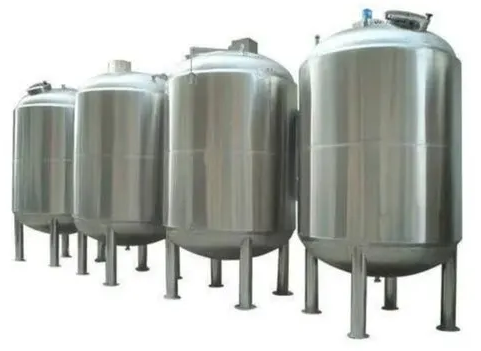Storage Tanks
Storage tanks in the food, pharmaceutical, chemical, and other industrial sectors are essential for holding liquids, chemicals, and sometimes gases. They are commonly made from stainless steel (SS) or mild steel (MS), with each material offering specific benefits suited to different storage needs. Choosing the right type of storage tank is essential to maintain product quality, safety, and process efficiency.

Stainless Steel (SS) Storage Tanks
- Material: Stainless steel tanks, often made from grades such as 304 or 316, are known for their corrosion resistance, durability, and hygienic properties, making them ideal for food, pharmaceutical, and chemical applications.
- Applications:
- Food and Beverage: Used for dairy, juice, beer, and other beverages to avoid contamination and preserve quality.
- Pharmaceuticals: Essential for holding raw materials, intermediates, and finished products, as they meet high hygiene and sterility standards.
- Chemicals: Suitable for storing corrosive chemicals, acids, and solvents due to stainless steel’s chemical resistance.
- Benefits:
- Corrosion Resistance: Stainless steel’s chromium content forms a protective oxide layer, preventing rust and corrosion, especially important in humid or acidic environments.
- Hygiene and Cleanability: Stainless steel surfaces are non-porous and easy to clean, making them ideal for applications requiring strict hygiene.
- Longevity: Stainless steel tanks have a long service life, often lasting decades with proper maintenance.
- Compatibility with Temperature Variations: Stainless steel can withstand extreme temperatures, making it ideal for hot and cold storage.
- Limitations:
- Cost: Stainless steel tanks are more expensive than mild steel due to the cost of materials.
- Weight: These tanks can be heavier, which may require additional structural support in larger installations.
Mild Steel (MS) Storage Tanks
- Material: Mild steel, which is low in carbon content, offers strength and durability but lacks the corrosion resistance of stainless steel. It’s often coated or painted to enhance durability.
- Applications:
- Water Storage: Used in industrial and agricultural applications for large-volume water storage.
- Oil and Fuel Storage: Commonly used to store oils, fuels, and other non-corrosive chemicals when properly coated to prevent rust.
- Industrial Liquids: Suitable for non-corrosive industrial liquids and wastewater, typically with internal and external protective coatings.
- Benefits:
- Cost-Effective: Mild steel is generally cheaper than stainless steel, making it a budget-friendly option for large storage needs.
- Strength and Toughness: Mild steel has high mechanical strength, making it suitable for high-capacity tanks.
- Easy Fabrication and Repair: Mild steel is easier to fabricate, weld, and repair, allowing for customization and cost-effective maintenance.
- Limitations:
- Corrosion Susceptibility: Without proper coating, mild steel is prone to rust and corrosion, limiting its use with acidic or corrosive substances.
- Maintenance: Requires frequent maintenance, including repainting or recoating, to prevent rusting.
- Shorter Lifespan: Mild steel tanks typically have a shorter life span compared to stainless steel, especially when storing harsh chemicals.
Coating and Linings
- Epoxy Coating: Commonly applied to the interior of mild steel tanks to resist corrosion and protect stored products from contamination.
- Rubber Lining: Used in tanks storing acidic or highly reactive chemicals, often for both stainless and mild steel tanks, to further extend life.
- Glass Lining: In certain food and chemical industries, glass-lined steel tanks provide chemical inertness and a smooth, cleanable surface.
Types of Storage Tanks
- Vertical Storage Tanks: Ideal for space-saving and high-capacity storage. They are commonly used for water, oils, and other bulk liquids.
- Horizontal Storage Tanks: Often used for transportation and installation in confined spaces; commonly applied in fuel storage.
- Pressurized Tanks: Used for gases or liquids under pressure, designed to prevent leakage under high-pressure conditions.
- Double-Walled Tanks: Provide additional protection and containment for hazardous chemicals and prevent leaks.
Regulatory Compliance and Safety Considerations
- Food and Pharmaceutical Standards: Stainless steel tanks must meet food-grade standards, like FDA or EU regulations, and pharmaceutical Good Manufacturing Practices (GMP).
- Corrosion and Leakage Prevention: Safety standards such as API 650 and API 653 (from the American Petroleum Institute) and ISO certifications are commonly applied, requiring tanks to have specific features for environmental safety.
- Fire Safety: Tanks storing flammable materials must have additional safety features, such as venting, grounding, and flame arrestors, to prevent fire hazards.
Choosing Between SS and MS Tanks
- For Corrosive Materials: Stainless steel is usually preferred due to its resistance to corrosion.
- For Non-Corrosive or Temporary Storage: Mild steel tanks can be an economical choice, especially with coatings.
- Budget Constraints: Mild steel tanks are cost-effective for large-volume storage, although maintenance costs should be considered.
